Unilever's Business Strategy: Macro Environment, VRIO and Value Chain
VerifiedAdded on 2023/06/18
|16
|4558
|145
Report
AI Summary
This report provides an in-depth analysis of Unilever's business strategy, examining the impact of the macro environment through PESTLE and SWOT analyses. It evaluates Unilever's internal environment and capabilities using the VRIO/VRIN framework and Porter's Value Chain analysis, justifying the company's existing competitive advantages. The report also discusses formulating strategies for overall success, evaluating these strategies using the Ansoff matrix, and recommending ways to monitor their effectiveness. The analysis covers Unilever's vision, mission, objectives, and core values, highlighting its strengths, weaknesses, opportunities, and threats, ultimately providing a comprehensive overview of Unilever's strategic positioning and future prospects.
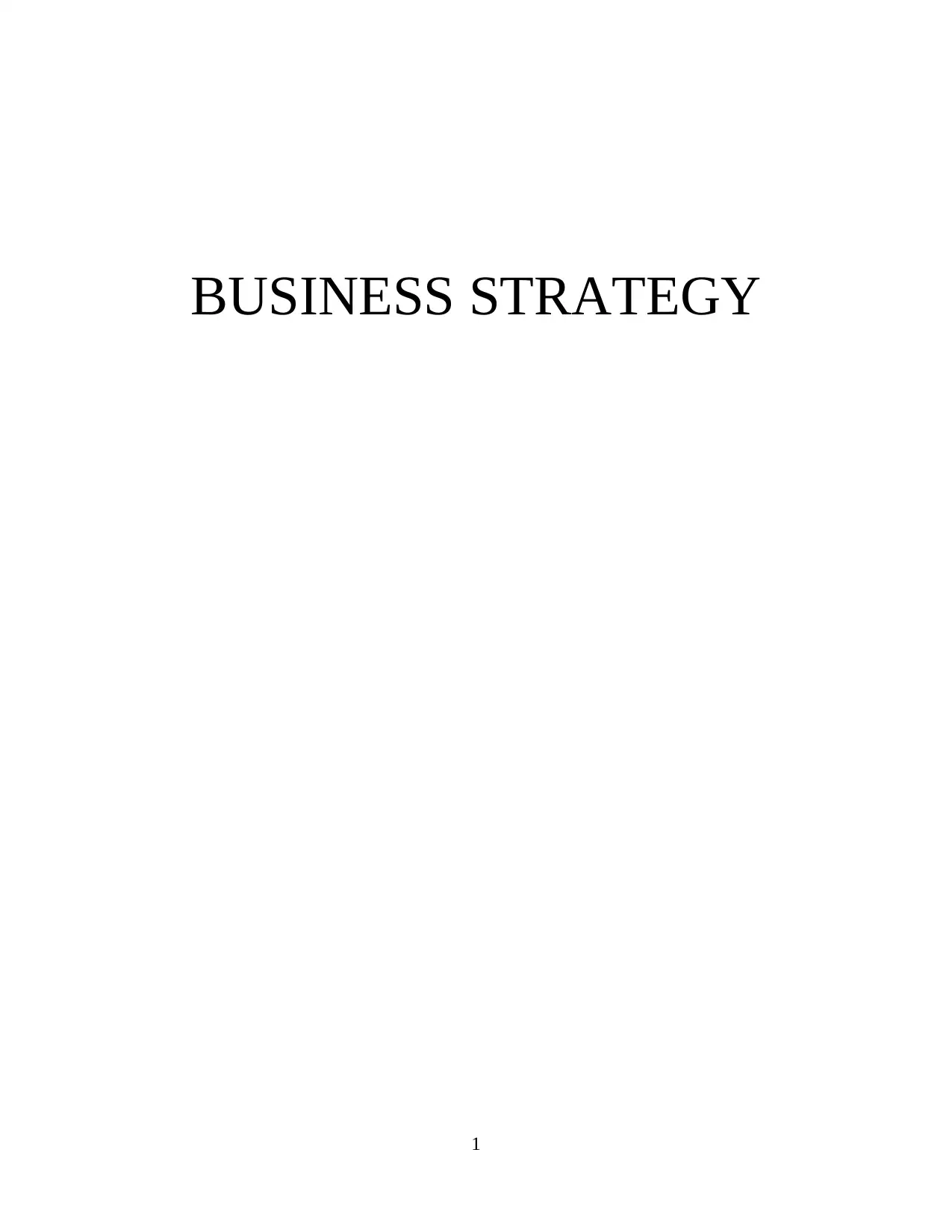
BUSINESS STRATEGY
1
1
Paraphrase This Document
Need a fresh take? Get an instant paraphrase of this document with our AI Paraphraser
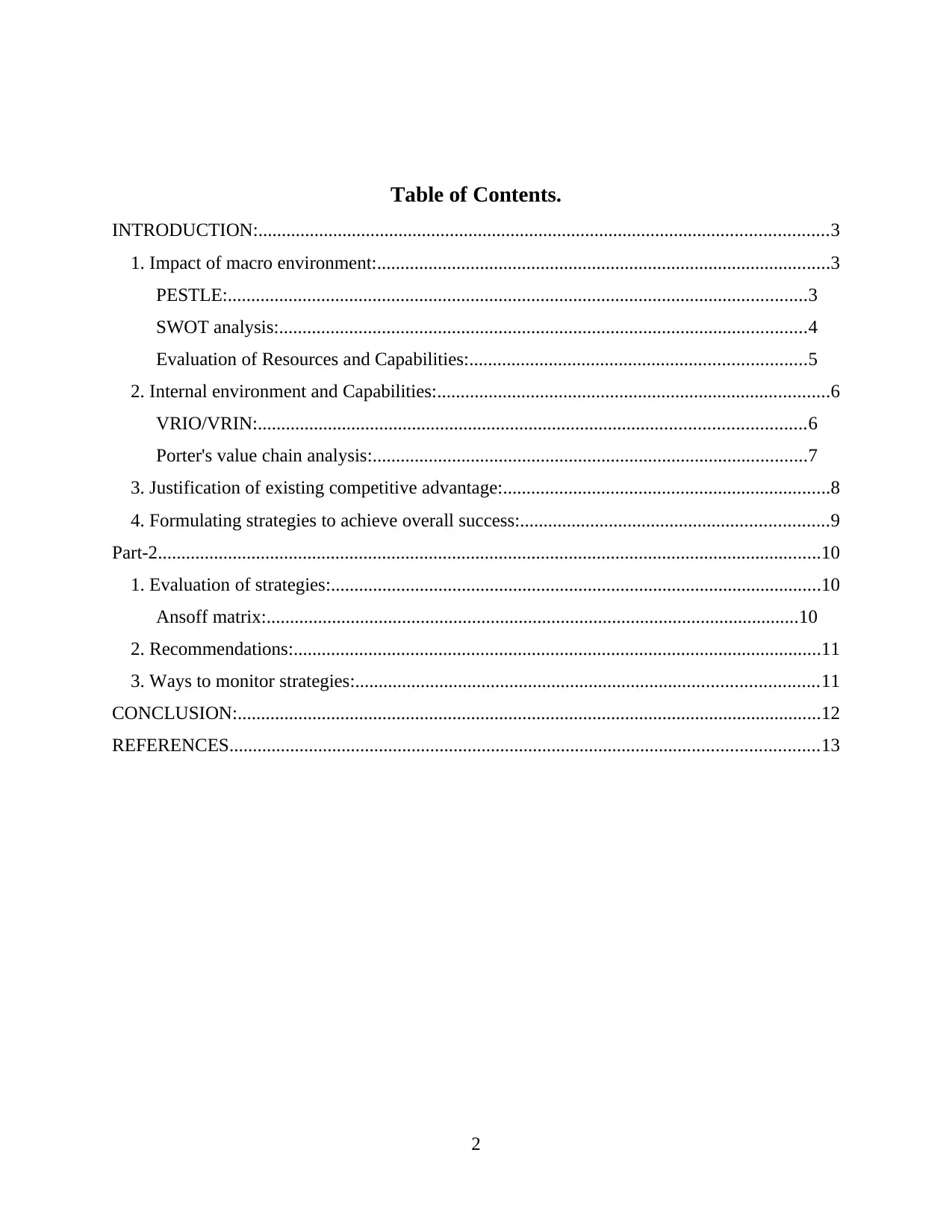
Table of Contents.
INTRODUCTION:..........................................................................................................................3
1. Impact of macro environment:.................................................................................................3
PESTLE:............................................................................................................................3
SWOT analysis:.................................................................................................................4
Evaluation of Resources and Capabilities:........................................................................5
2. Internal environment and Capabilities:....................................................................................6
VRIO/VRIN:.....................................................................................................................6
Porter's value chain analysis:.............................................................................................7
3. Justification of existing competitive advantage:......................................................................8
4. Formulating strategies to achieve overall success:..................................................................9
Part-2..............................................................................................................................................10
1. Evaluation of strategies:.........................................................................................................10
Ansoff matrix:..................................................................................................................10
2. Recommendations:.................................................................................................................11
3. Ways to monitor strategies:...................................................................................................11
CONCLUSION:.............................................................................................................................12
REFERENCES..............................................................................................................................13
2
INTRODUCTION:..........................................................................................................................3
1. Impact of macro environment:.................................................................................................3
PESTLE:............................................................................................................................3
SWOT analysis:.................................................................................................................4
Evaluation of Resources and Capabilities:........................................................................5
2. Internal environment and Capabilities:....................................................................................6
VRIO/VRIN:.....................................................................................................................6
Porter's value chain analysis:.............................................................................................7
3. Justification of existing competitive advantage:......................................................................8
4. Formulating strategies to achieve overall success:..................................................................9
Part-2..............................................................................................................................................10
1. Evaluation of strategies:.........................................................................................................10
Ansoff matrix:..................................................................................................................10
2. Recommendations:.................................................................................................................11
3. Ways to monitor strategies:...................................................................................................11
CONCLUSION:.............................................................................................................................12
REFERENCES..............................................................................................................................13
2
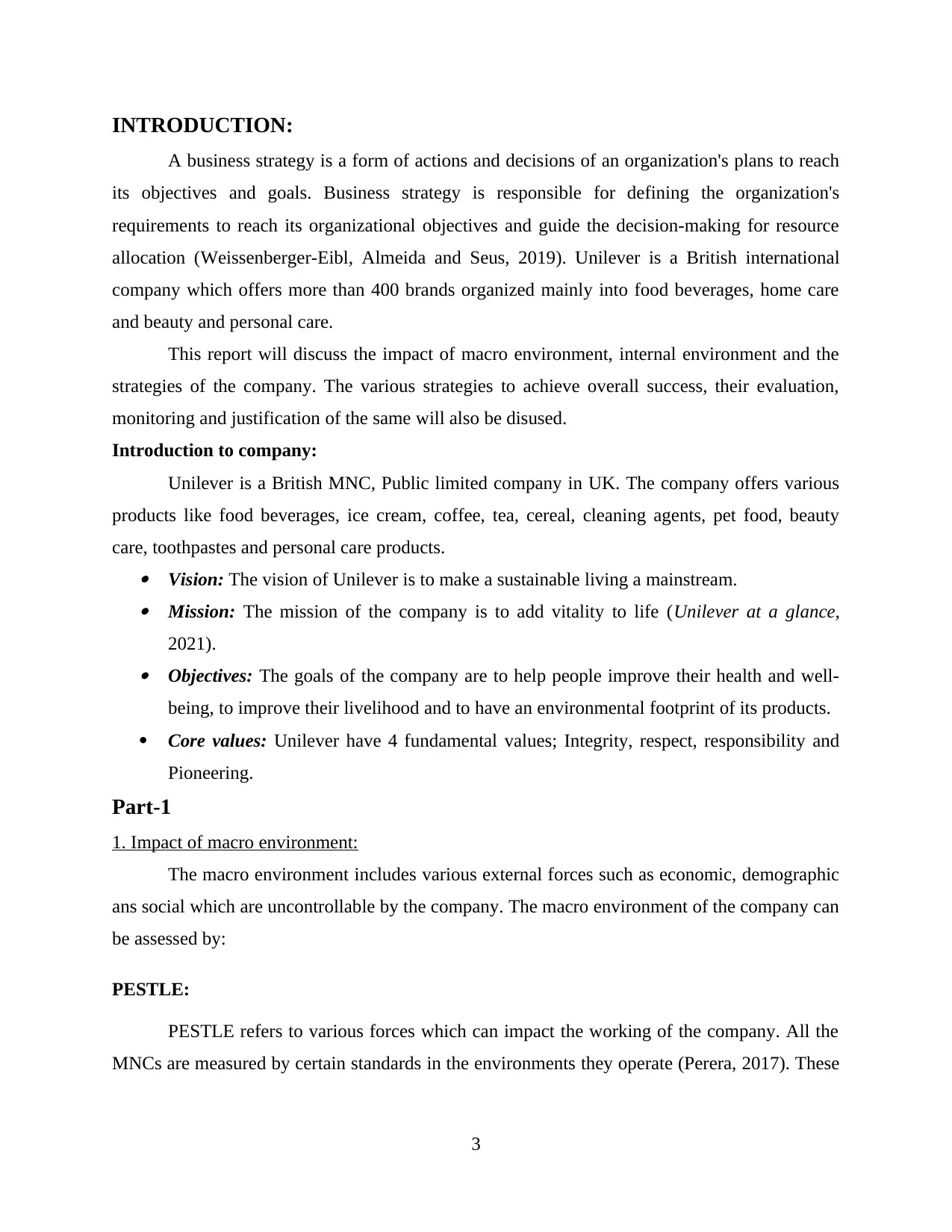
INTRODUCTION:
A business strategy is a form of actions and decisions of an organization's plans to reach
its objectives and goals. Business strategy is responsible for defining the organization's
requirements to reach its organizational objectives and guide the decision-making for resource
allocation (Weissenberger-Eibl, Almeida and Seus, 2019). Unilever is a British international
company which offers more than 400 brands organized mainly into food beverages, home care
and beauty and personal care.
This report will discuss the impact of macro environment, internal environment and the
strategies of the company. The various strategies to achieve overall success, their evaluation,
monitoring and justification of the same will also be disused.
Introduction to company:
Unilever is a British MNC, Public limited company in UK. The company offers various
products like food beverages, ice cream, coffee, tea, cereal, cleaning agents, pet food, beauty
care, toothpastes and personal care products. Vision: The vision of Unilever is to make a sustainable living a mainstream. Mission: The mission of the company is to add vitality to life (Unilever at a glance,
2021). Objectives: The goals of the company are to help people improve their health and well-
being, to improve their livelihood and to have an environmental footprint of its products.
Core values: Unilever have 4 fundamental values; Integrity, respect, responsibility and
Pioneering.
Part-1
1. Impact of macro environment:
The macro environment includes various external forces such as economic, demographic
ans social which are uncontrollable by the company. The macro environment of the company can
be assessed by:
PESTLE:
PESTLE refers to various forces which can impact the working of the company. All the
MNCs are measured by certain standards in the environments they operate (Perera, 2017). These
3
A business strategy is a form of actions and decisions of an organization's plans to reach
its objectives and goals. Business strategy is responsible for defining the organization's
requirements to reach its organizational objectives and guide the decision-making for resource
allocation (Weissenberger-Eibl, Almeida and Seus, 2019). Unilever is a British international
company which offers more than 400 brands organized mainly into food beverages, home care
and beauty and personal care.
This report will discuss the impact of macro environment, internal environment and the
strategies of the company. The various strategies to achieve overall success, their evaluation,
monitoring and justification of the same will also be disused.
Introduction to company:
Unilever is a British MNC, Public limited company in UK. The company offers various
products like food beverages, ice cream, coffee, tea, cereal, cleaning agents, pet food, beauty
care, toothpastes and personal care products. Vision: The vision of Unilever is to make a sustainable living a mainstream. Mission: The mission of the company is to add vitality to life (Unilever at a glance,
2021). Objectives: The goals of the company are to help people improve their health and well-
being, to improve their livelihood and to have an environmental footprint of its products.
Core values: Unilever have 4 fundamental values; Integrity, respect, responsibility and
Pioneering.
Part-1
1. Impact of macro environment:
The macro environment includes various external forces such as economic, demographic
ans social which are uncontrollable by the company. The macro environment of the company can
be assessed by:
PESTLE:
PESTLE refers to various forces which can impact the working of the company. All the
MNCs are measured by certain standards in the environments they operate (Perera, 2017). These
3
You're viewing a preview
Unlock full access by subscribing today!
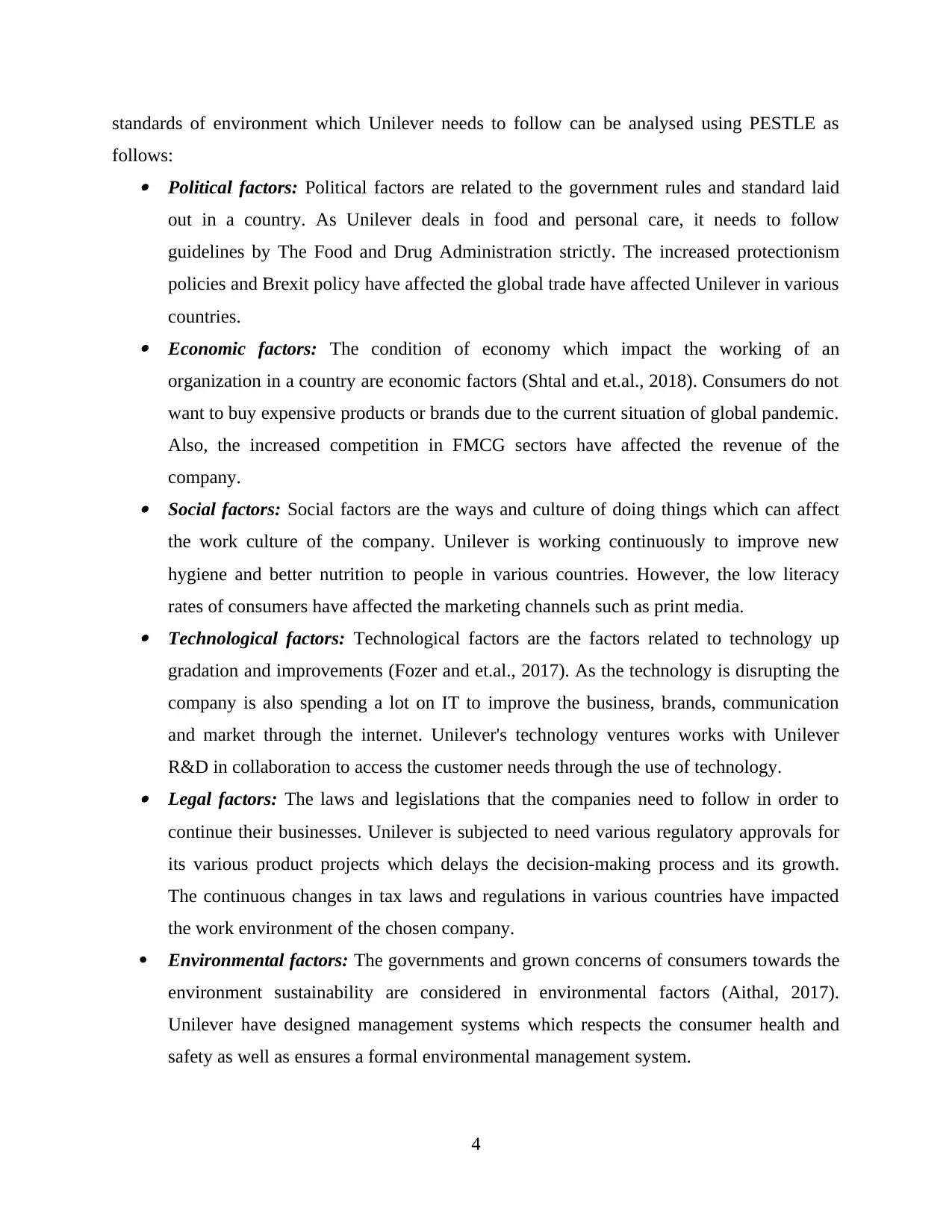
standards of environment which Unilever needs to follow can be analysed using PESTLE as
follows: Political factors: Political factors are related to the government rules and standard laid
out in a country. As Unilever deals in food and personal care, it needs to follow
guidelines by The Food and Drug Administration strictly. The increased protectionism
policies and Brexit policy have affected the global trade have affected Unilever in various
countries. Economic factors: The condition of economy which impact the working of an
organization in a country are economic factors (Shtal and et.al., 2018). Consumers do not
want to buy expensive products or brands due to the current situation of global pandemic.
Also, the increased competition in FMCG sectors have affected the revenue of the
company. Social factors: Social factors are the ways and culture of doing things which can affect
the work culture of the company. Unilever is working continuously to improve new
hygiene and better nutrition to people in various countries. However, the low literacy
rates of consumers have affected the marketing channels such as print media. Technological factors: Technological factors are the factors related to technology up
gradation and improvements (Fozer and et.al., 2017). As the technology is disrupting the
company is also spending a lot on IT to improve the business, brands, communication
and market through the internet. Unilever's technology ventures works with Unilever
R&D in collaboration to access the customer needs through the use of technology. Legal factors: The laws and legislations that the companies need to follow in order to
continue their businesses. Unilever is subjected to need various regulatory approvals for
its various product projects which delays the decision-making process and its growth.
The continuous changes in tax laws and regulations in various countries have impacted
the work environment of the chosen company.
Environmental factors: The governments and grown concerns of consumers towards the
environment sustainability are considered in environmental factors (Aithal, 2017).
Unilever have designed management systems which respects the consumer health and
safety as well as ensures a formal environmental management system.
4
follows: Political factors: Political factors are related to the government rules and standard laid
out in a country. As Unilever deals in food and personal care, it needs to follow
guidelines by The Food and Drug Administration strictly. The increased protectionism
policies and Brexit policy have affected the global trade have affected Unilever in various
countries. Economic factors: The condition of economy which impact the working of an
organization in a country are economic factors (Shtal and et.al., 2018). Consumers do not
want to buy expensive products or brands due to the current situation of global pandemic.
Also, the increased competition in FMCG sectors have affected the revenue of the
company. Social factors: Social factors are the ways and culture of doing things which can affect
the work culture of the company. Unilever is working continuously to improve new
hygiene and better nutrition to people in various countries. However, the low literacy
rates of consumers have affected the marketing channels such as print media. Technological factors: Technological factors are the factors related to technology up
gradation and improvements (Fozer and et.al., 2017). As the technology is disrupting the
company is also spending a lot on IT to improve the business, brands, communication
and market through the internet. Unilever's technology ventures works with Unilever
R&D in collaboration to access the customer needs through the use of technology. Legal factors: The laws and legislations that the companies need to follow in order to
continue their businesses. Unilever is subjected to need various regulatory approvals for
its various product projects which delays the decision-making process and its growth.
The continuous changes in tax laws and regulations in various countries have impacted
the work environment of the chosen company.
Environmental factors: The governments and grown concerns of consumers towards the
environment sustainability are considered in environmental factors (Aithal, 2017).
Unilever have designed management systems which respects the consumer health and
safety as well as ensures a formal environmental management system.
4
Paraphrase This Document
Need a fresh take? Get an instant paraphrase of this document with our AI Paraphraser
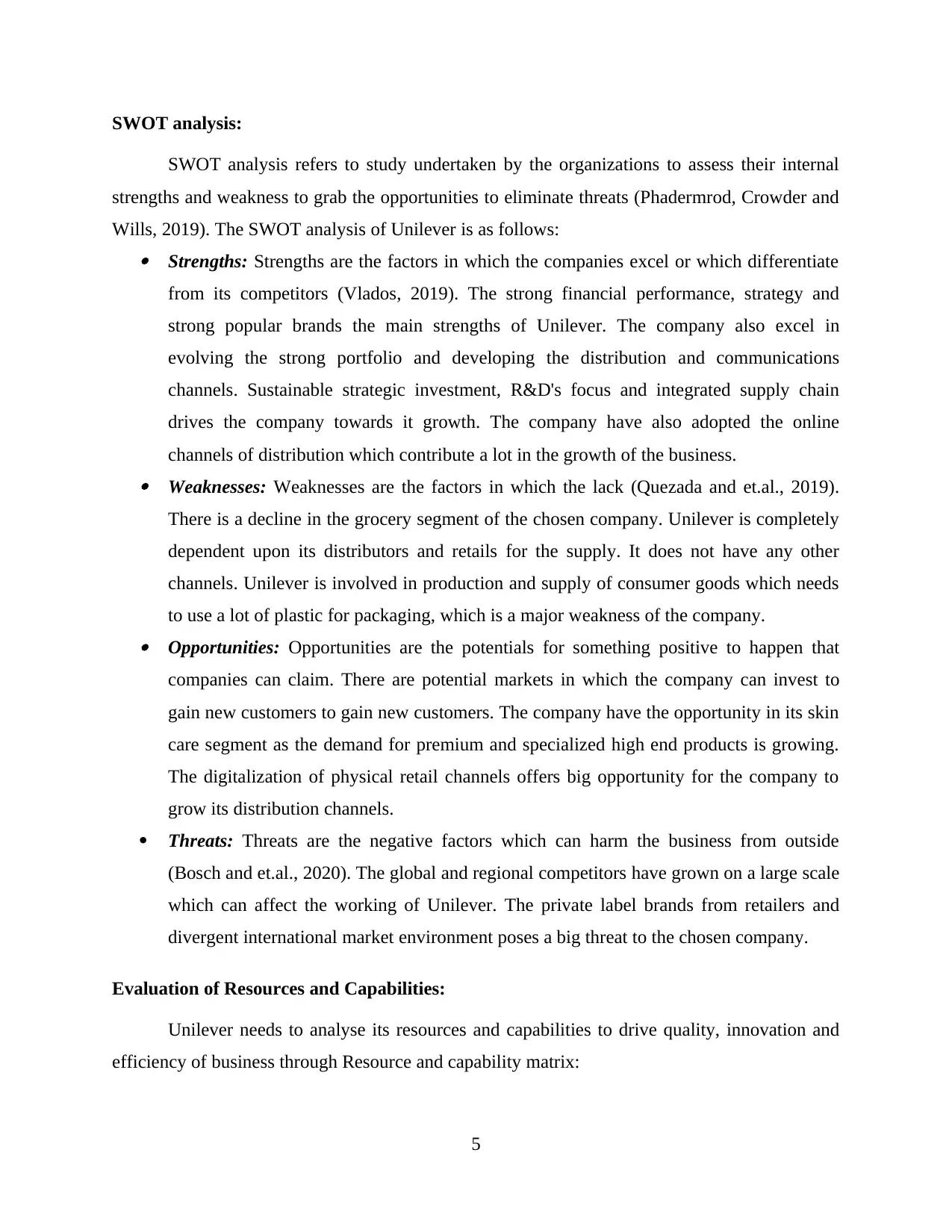
SWOT analysis:
SWOT analysis refers to study undertaken by the organizations to assess their internal
strengths and weakness to grab the opportunities to eliminate threats (Phadermrod, Crowder and
Wills, 2019). The SWOT analysis of Unilever is as follows: Strengths: Strengths are the factors in which the companies excel or which differentiate
from its competitors (Vlados, 2019). The strong financial performance, strategy and
strong popular brands the main strengths of Unilever. The company also excel in
evolving the strong portfolio and developing the distribution and communications
channels. Sustainable strategic investment, R&D's focus and integrated supply chain
drives the company towards it growth. The company have also adopted the online
channels of distribution which contribute a lot in the growth of the business. Weaknesses: Weaknesses are the factors in which the lack (Quezada and et.al., 2019).
There is a decline in the grocery segment of the chosen company. Unilever is completely
dependent upon its distributors and retails for the supply. It does not have any other
channels. Unilever is involved in production and supply of consumer goods which needs
to use a lot of plastic for packaging, which is a major weakness of the company. Opportunities: Opportunities are the potentials for something positive to happen that
companies can claim. There are potential markets in which the company can invest to
gain new customers to gain new customers. The company have the opportunity in its skin
care segment as the demand for premium and specialized high end products is growing.
The digitalization of physical retail channels offers big opportunity for the company to
grow its distribution channels.
Threats: Threats are the negative factors which can harm the business from outside
(Bosch and et.al., 2020). The global and regional competitors have grown on a large scale
which can affect the working of Unilever. The private label brands from retailers and
divergent international market environment poses a big threat to the chosen company.
Evaluation of Resources and Capabilities:
Unilever needs to analyse its resources and capabilities to drive quality, innovation and
efficiency of business through Resource and capability matrix:
5
SWOT analysis refers to study undertaken by the organizations to assess their internal
strengths and weakness to grab the opportunities to eliminate threats (Phadermrod, Crowder and
Wills, 2019). The SWOT analysis of Unilever is as follows: Strengths: Strengths are the factors in which the companies excel or which differentiate
from its competitors (Vlados, 2019). The strong financial performance, strategy and
strong popular brands the main strengths of Unilever. The company also excel in
evolving the strong portfolio and developing the distribution and communications
channels. Sustainable strategic investment, R&D's focus and integrated supply chain
drives the company towards it growth. The company have also adopted the online
channels of distribution which contribute a lot in the growth of the business. Weaknesses: Weaknesses are the factors in which the lack (Quezada and et.al., 2019).
There is a decline in the grocery segment of the chosen company. Unilever is completely
dependent upon its distributors and retails for the supply. It does not have any other
channels. Unilever is involved in production and supply of consumer goods which needs
to use a lot of plastic for packaging, which is a major weakness of the company. Opportunities: Opportunities are the potentials for something positive to happen that
companies can claim. There are potential markets in which the company can invest to
gain new customers to gain new customers. The company have the opportunity in its skin
care segment as the demand for premium and specialized high end products is growing.
The digitalization of physical retail channels offers big opportunity for the company to
grow its distribution channels.
Threats: Threats are the negative factors which can harm the business from outside
(Bosch and et.al., 2020). The global and regional competitors have grown on a large scale
which can affect the working of Unilever. The private label brands from retailers and
divergent international market environment poses a big threat to the chosen company.
Evaluation of Resources and Capabilities:
Unilever needs to analyse its resources and capabilities to drive quality, innovation and
efficiency of business through Resource and capability matrix:
5
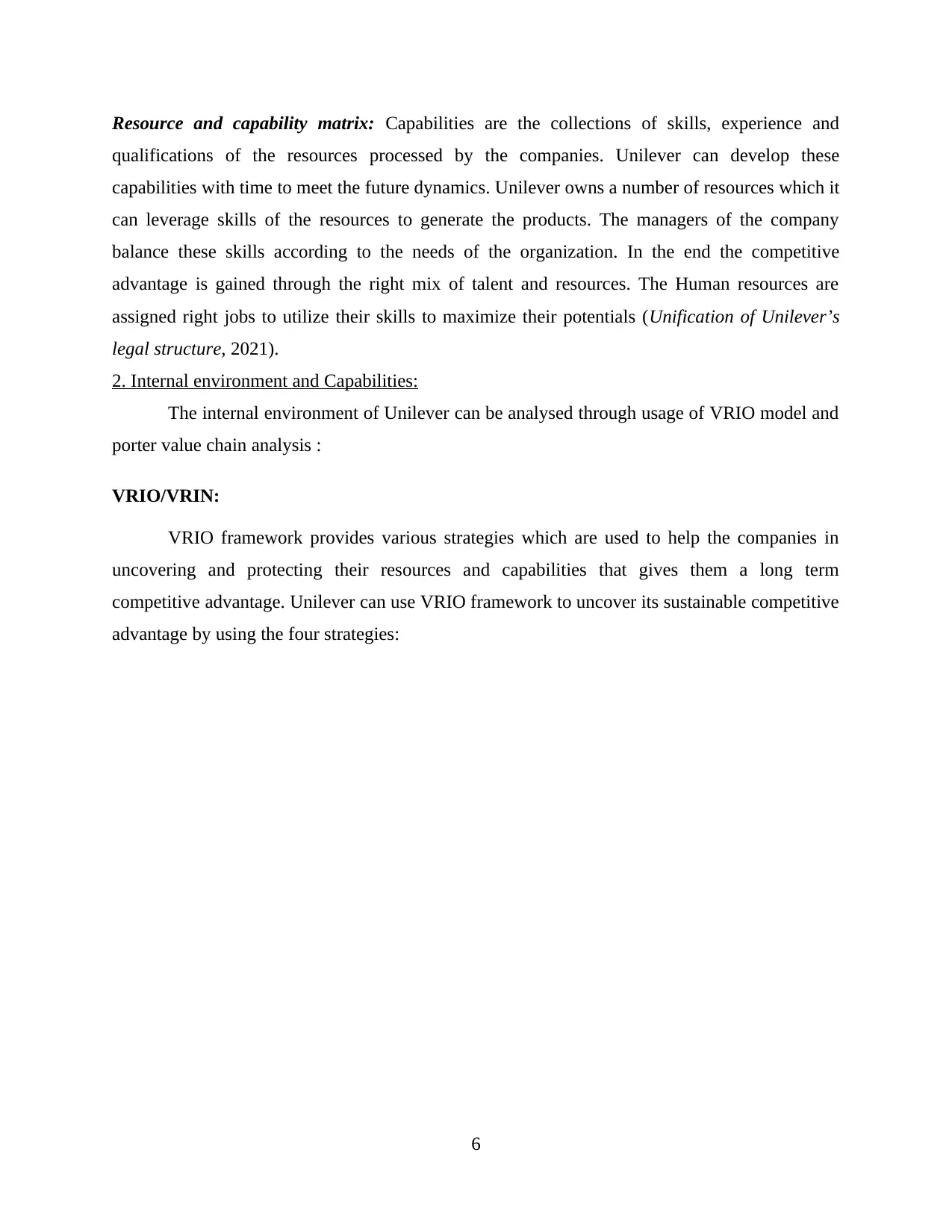
Resource and capability matrix: Capabilities are the collections of skills, experience and
qualifications of the resources processed by the companies. Unilever can develop these
capabilities with time to meet the future dynamics. Unilever owns a number of resources which it
can leverage skills of the resources to generate the products. The managers of the company
balance these skills according to the needs of the organization. In the end the competitive
advantage is gained through the right mix of talent and resources. The Human resources are
assigned right jobs to utilize their skills to maximize their potentials (Unification of Unilever’s
legal structure, 2021).
2. Internal environment and Capabilities:
The internal environment of Unilever can be analysed through usage of VRIO model and
porter value chain analysis :
VRIO/VRIN:
VRIO framework provides various strategies which are used to help the companies in
uncovering and protecting their resources and capabilities that gives them a long term
competitive advantage. Unilever can use VRIO framework to uncover its sustainable competitive
advantage by using the four strategies:
6
qualifications of the resources processed by the companies. Unilever can develop these
capabilities with time to meet the future dynamics. Unilever owns a number of resources which it
can leverage skills of the resources to generate the products. The managers of the company
balance these skills according to the needs of the organization. In the end the competitive
advantage is gained through the right mix of talent and resources. The Human resources are
assigned right jobs to utilize their skills to maximize their potentials (Unification of Unilever’s
legal structure, 2021).
2. Internal environment and Capabilities:
The internal environment of Unilever can be analysed through usage of VRIO model and
porter value chain analysis :
VRIO/VRIN:
VRIO framework provides various strategies which are used to help the companies in
uncovering and protecting their resources and capabilities that gives them a long term
competitive advantage. Unilever can use VRIO framework to uncover its sustainable competitive
advantage by using the four strategies:
6
You're viewing a preview
Unlock full access by subscribing today!
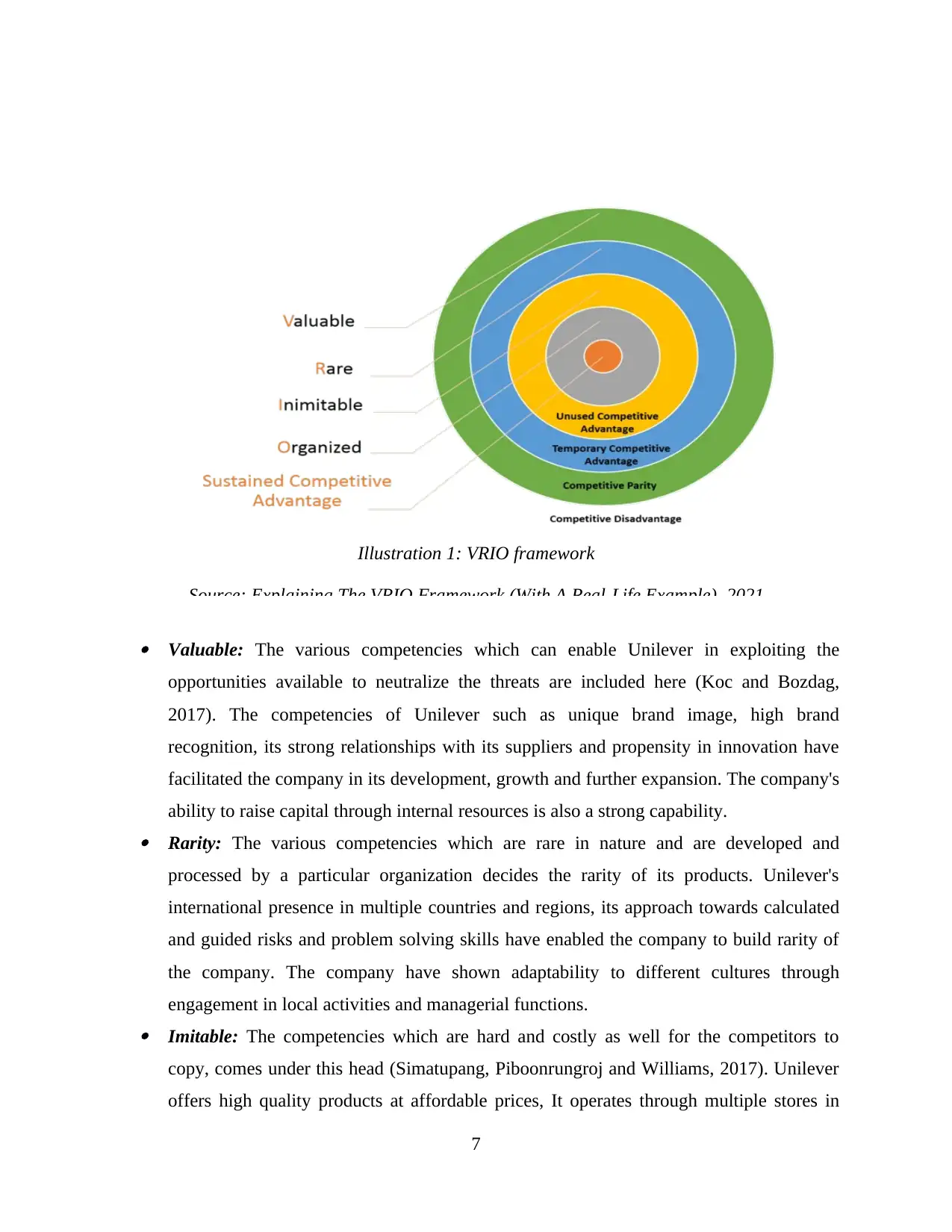
Valuable: The various competencies which can enable Unilever in exploiting the
opportunities available to neutralize the threats are included here (Koc and Bozdag,
2017). The competencies of Unilever such as unique brand image, high brand
recognition, its strong relationships with its suppliers and propensity in innovation have
facilitated the company in its development, growth and further expansion. The company's
ability to raise capital through internal resources is also a strong capability. Rarity: The various competencies which are rare in nature and are developed and
processed by a particular organization decides the rarity of its products. Unilever's
international presence in multiple countries and regions, its approach towards calculated
and guided risks and problem solving skills have enabled the company to build rarity of
the company. The company have shown adaptability to different cultures through
engagement in local activities and managerial functions. Imitable: The competencies which are hard and costly as well for the competitors to
copy, comes under this head (Simatupang, Piboonrungroj and Williams, 2017). Unilever
offers high quality products at affordable prices, It operates through multiple stores in
7
Illustration 1: VRIO framework
Source: Explaining The VRIO Framework (With A Real-Life Example), 2021
opportunities available to neutralize the threats are included here (Koc and Bozdag,
2017). The competencies of Unilever such as unique brand image, high brand
recognition, its strong relationships with its suppliers and propensity in innovation have
facilitated the company in its development, growth and further expansion. The company's
ability to raise capital through internal resources is also a strong capability. Rarity: The various competencies which are rare in nature and are developed and
processed by a particular organization decides the rarity of its products. Unilever's
international presence in multiple countries and regions, its approach towards calculated
and guided risks and problem solving skills have enabled the company to build rarity of
the company. The company have shown adaptability to different cultures through
engagement in local activities and managerial functions. Imitable: The competencies which are hard and costly as well for the competitors to
copy, comes under this head (Simatupang, Piboonrungroj and Williams, 2017). Unilever
offers high quality products at affordable prices, It operates through multiple stores in
7
Illustration 1: VRIO framework
Source: Explaining The VRIO Framework (With A Real-Life Example), 2021
Paraphrase This Document
Need a fresh take? Get an instant paraphrase of this document with our AI Paraphraser

different countries, marketing communications and competitive pricing are imitable
competencies of Unilever. Unilever also provides its customers a unique experience
which differentiates it from others.
Organization/ Non-substitute: The factors or competencies which are developed only the
company that cannot be copied other companies are the non-substitutes of the company.
Unilever's competencies such as its financial strength, technological advancement, in
house training to the employees, production capacity, well-trained Human resources,
supportive organizational and its huge investments in research and developments creates
non substitute competencies.
Porter's value chain analysis:
Porter's Value chain analysis is an integration of activities which focuses on systems and
activities with the customers as central to create values for its customers (Ricciotti, 2020).
Unilever can use Porter's value chain analysis as following:
Porter's value chain involves primary activities as following:
Primary activities are those activities which are directly involved in production and sales
of the products to the target customers of the company. Unilever's primary activities are as
following: Inbound logistics: Developing relationships with suppliers is important to receive, store
and distribute the products which needs analysis of in-bound logistics. Without this
Unilever faces various challenge in product development phases. Operations: The analysis of operational activities is necessary as when the raw material
is procured, Unilever needs to be ready to process the raw material into the finished
product and launching it in the market. Outbound logistics: Unilever needs to pay more attention to the outbound value chain
activities of material handling and warehousing etc. when the products offered are of
perishable nature (Unilever at a glance, 2021). Marketing and sales: The company spends a huge amount of finance in marketing and
the sales of its products. The company does this to promote the customer loyalty and
healthy relationships, equality and competitiveness of its brand.
8
competencies of Unilever. Unilever also provides its customers a unique experience
which differentiates it from others.
Organization/ Non-substitute: The factors or competencies which are developed only the
company that cannot be copied other companies are the non-substitutes of the company.
Unilever's competencies such as its financial strength, technological advancement, in
house training to the employees, production capacity, well-trained Human resources,
supportive organizational and its huge investments in research and developments creates
non substitute competencies.
Porter's value chain analysis:
Porter's Value chain analysis is an integration of activities which focuses on systems and
activities with the customers as central to create values for its customers (Ricciotti, 2020).
Unilever can use Porter's value chain analysis as following:
Porter's value chain involves primary activities as following:
Primary activities are those activities which are directly involved in production and sales
of the products to the target customers of the company. Unilever's primary activities are as
following: Inbound logistics: Developing relationships with suppliers is important to receive, store
and distribute the products which needs analysis of in-bound logistics. Without this
Unilever faces various challenge in product development phases. Operations: The analysis of operational activities is necessary as when the raw material
is procured, Unilever needs to be ready to process the raw material into the finished
product and launching it in the market. Outbound logistics: Unilever needs to pay more attention to the outbound value chain
activities of material handling and warehousing etc. when the products offered are of
perishable nature (Unilever at a glance, 2021). Marketing and sales: The company spends a huge amount of finance in marketing and
the sales of its products. The company does this to promote the customer loyalty and
healthy relationships, equality and competitiveness of its brand.
8
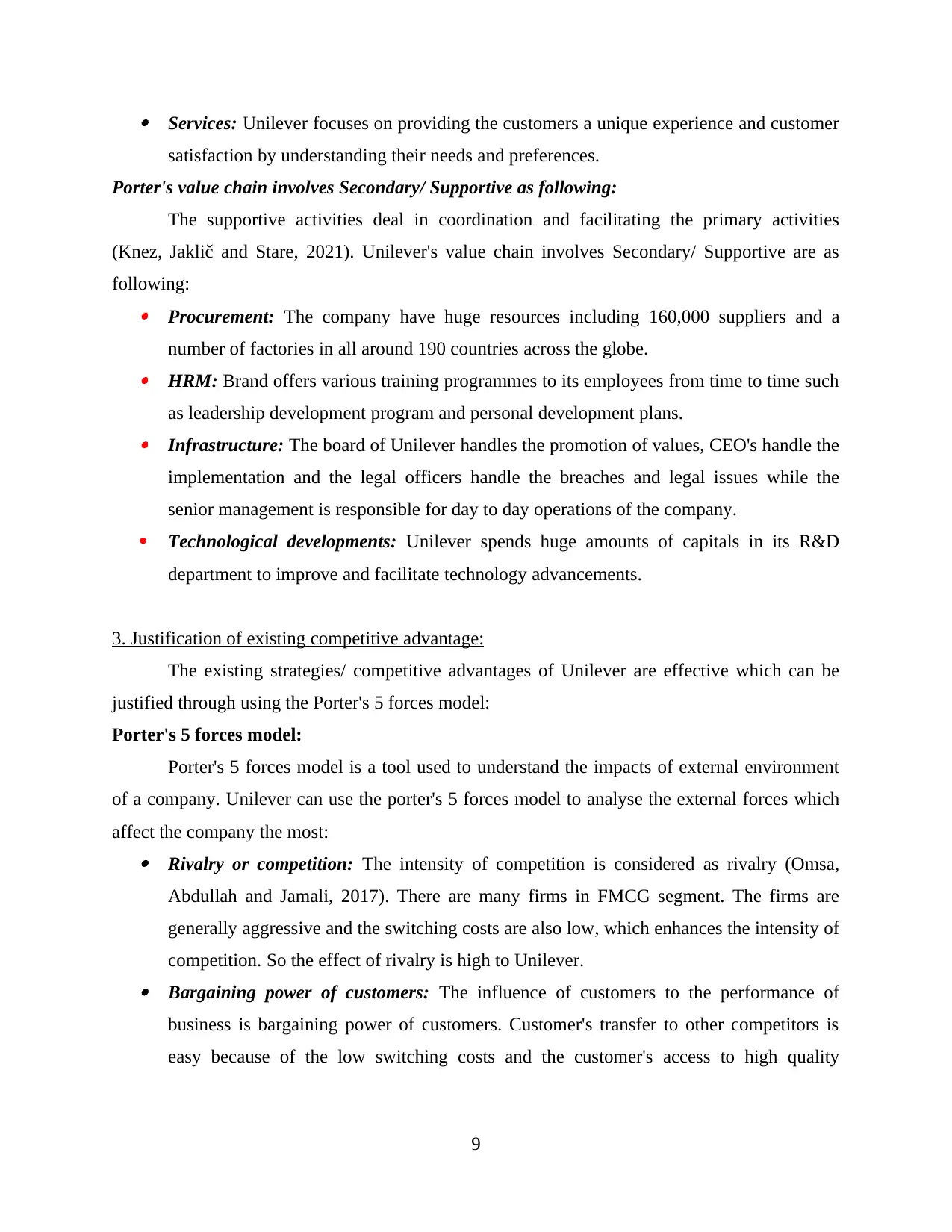
Services: Unilever focuses on providing the customers a unique experience and customer
satisfaction by understanding their needs and preferences.
Porter's value chain involves Secondary/ Supportive as following:
The supportive activities deal in coordination and facilitating the primary activities
(Knez, Jaklič and Stare, 2021). Unilever's value chain involves Secondary/ Supportive are as
following: Procurement: The company have huge resources including 160,000 suppliers and a
number of factories in all around 190 countries across the globe. HRM: Brand offers various training programmes to its employees from time to time such
as leadership development program and personal development plans. Infrastructure: The board of Unilever handles the promotion of values, CEO's handle the
implementation and the legal officers handle the breaches and legal issues while the
senior management is responsible for day to day operations of the company.
Technological developments: Unilever spends huge amounts of capitals in its R&D
department to improve and facilitate technology advancements.
3. Justification of existing competitive advantage:
The existing strategies/ competitive advantages of Unilever are effective which can be
justified through using the Porter's 5 forces model:
Porter's 5 forces model:
Porter's 5 forces model is a tool used to understand the impacts of external environment
of a company. Unilever can use the porter's 5 forces model to analyse the external forces which
affect the company the most: Rivalry or competition: The intensity of competition is considered as rivalry (Omsa,
Abdullah and Jamali, 2017). There are many firms in FMCG segment. The firms are
generally aggressive and the switching costs are also low, which enhances the intensity of
competition. So the effect of rivalry is high to Unilever. Bargaining power of customers: The influence of customers to the performance of
business is bargaining power of customers. Customer's transfer to other competitors is
easy because of the low switching costs and the customer's access to high quality
9
satisfaction by understanding their needs and preferences.
Porter's value chain involves Secondary/ Supportive as following:
The supportive activities deal in coordination and facilitating the primary activities
(Knez, Jaklič and Stare, 2021). Unilever's value chain involves Secondary/ Supportive are as
following: Procurement: The company have huge resources including 160,000 suppliers and a
number of factories in all around 190 countries across the globe. HRM: Brand offers various training programmes to its employees from time to time such
as leadership development program and personal development plans. Infrastructure: The board of Unilever handles the promotion of values, CEO's handle the
implementation and the legal officers handle the breaches and legal issues while the
senior management is responsible for day to day operations of the company.
Technological developments: Unilever spends huge amounts of capitals in its R&D
department to improve and facilitate technology advancements.
3. Justification of existing competitive advantage:
The existing strategies/ competitive advantages of Unilever are effective which can be
justified through using the Porter's 5 forces model:
Porter's 5 forces model:
Porter's 5 forces model is a tool used to understand the impacts of external environment
of a company. Unilever can use the porter's 5 forces model to analyse the external forces which
affect the company the most: Rivalry or competition: The intensity of competition is considered as rivalry (Omsa,
Abdullah and Jamali, 2017). There are many firms in FMCG segment. The firms are
generally aggressive and the switching costs are also low, which enhances the intensity of
competition. So the effect of rivalry is high to Unilever. Bargaining power of customers: The influence of customers to the performance of
business is bargaining power of customers. Customer's transfer to other competitors is
easy because of the low switching costs and the customer's access to high quality
9
You're viewing a preview
Unlock full access by subscribing today!
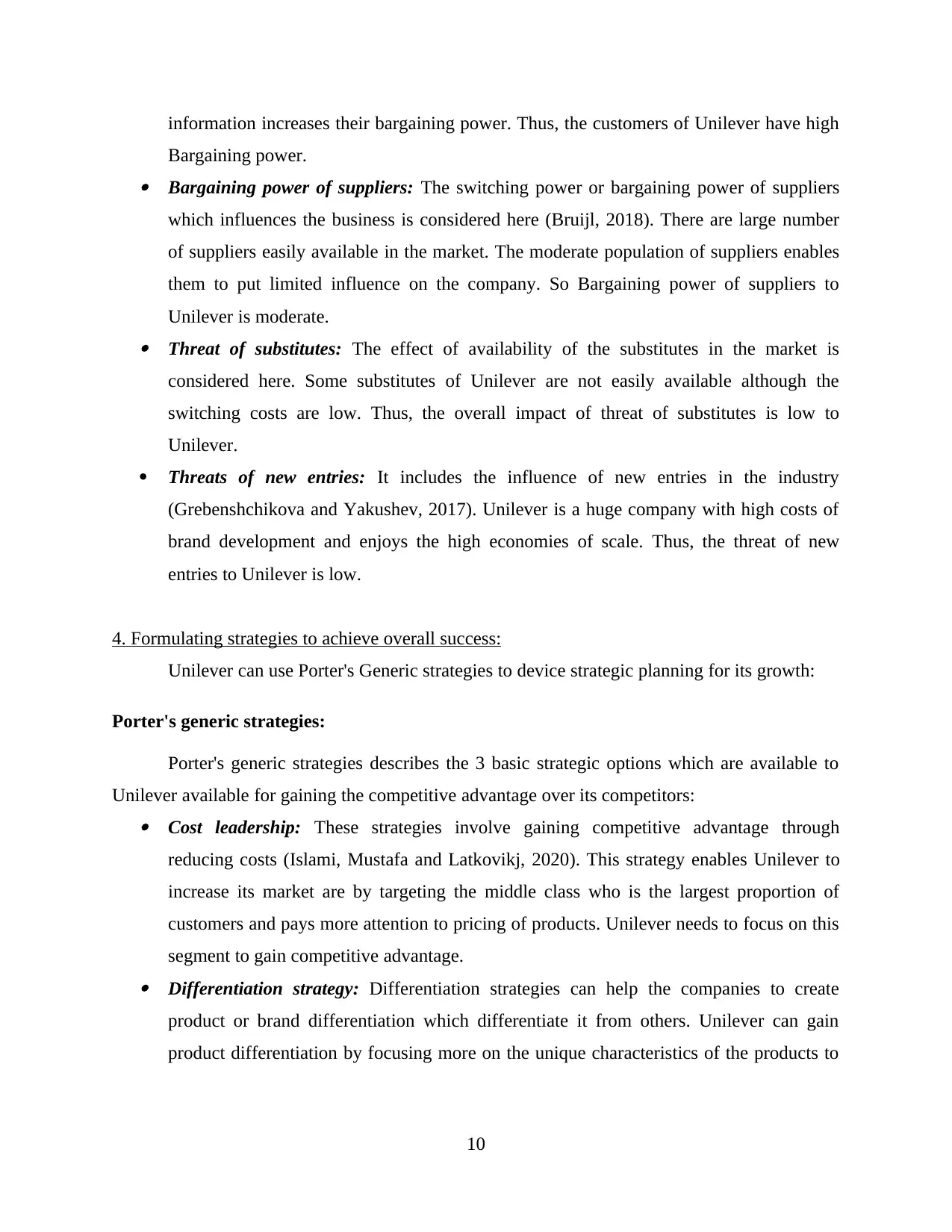
information increases their bargaining power. Thus, the customers of Unilever have high
Bargaining power. Bargaining power of suppliers: The switching power or bargaining power of suppliers
which influences the business is considered here (Bruijl, 2018). There are large number
of suppliers easily available in the market. The moderate population of suppliers enables
them to put limited influence on the company. So Bargaining power of suppliers to
Unilever is moderate. Threat of substitutes: The effect of availability of the substitutes in the market is
considered here. Some substitutes of Unilever are not easily available although the
switching costs are low. Thus, the overall impact of threat of substitutes is low to
Unilever.
Threats of new entries: It includes the influence of new entries in the industry
(Grebenshchikova and Yakushev, 2017). Unilever is a huge company with high costs of
brand development and enjoys the high economies of scale. Thus, the threat of new
entries to Unilever is low.
4. Formulating strategies to achieve overall success:
Unilever can use Porter's Generic strategies to device strategic planning for its growth:
Porter's generic strategies:
Porter's generic strategies describes the 3 basic strategic options which are available to
Unilever available for gaining the competitive advantage over its competitors: Cost leadership: These strategies involve gaining competitive advantage through
reducing costs (Islami, Mustafa and Latkovikj, 2020). This strategy enables Unilever to
increase its market are by targeting the middle class who is the largest proportion of
customers and pays more attention to pricing of products. Unilever needs to focus on this
segment to gain competitive advantage. Differentiation strategy: Differentiation strategies can help the companies to create
product or brand differentiation which differentiate it from others. Unilever can gain
product differentiation by focusing more on the unique characteristics of the products to
10
Bargaining power. Bargaining power of suppliers: The switching power or bargaining power of suppliers
which influences the business is considered here (Bruijl, 2018). There are large number
of suppliers easily available in the market. The moderate population of suppliers enables
them to put limited influence on the company. So Bargaining power of suppliers to
Unilever is moderate. Threat of substitutes: The effect of availability of the substitutes in the market is
considered here. Some substitutes of Unilever are not easily available although the
switching costs are low. Thus, the overall impact of threat of substitutes is low to
Unilever.
Threats of new entries: It includes the influence of new entries in the industry
(Grebenshchikova and Yakushev, 2017). Unilever is a huge company with high costs of
brand development and enjoys the high economies of scale. Thus, the threat of new
entries to Unilever is low.
4. Formulating strategies to achieve overall success:
Unilever can use Porter's Generic strategies to device strategic planning for its growth:
Porter's generic strategies:
Porter's generic strategies describes the 3 basic strategic options which are available to
Unilever available for gaining the competitive advantage over its competitors: Cost leadership: These strategies involve gaining competitive advantage through
reducing costs (Islami, Mustafa and Latkovikj, 2020). This strategy enables Unilever to
increase its market are by targeting the middle class who is the largest proportion of
customers and pays more attention to pricing of products. Unilever needs to focus on this
segment to gain competitive advantage. Differentiation strategy: Differentiation strategies can help the companies to create
product or brand differentiation which differentiate it from others. Unilever can gain
product differentiation by focusing more on the unique characteristics of the products to
10
Paraphrase This Document
Need a fresh take? Get an instant paraphrase of this document with our AI Paraphraser
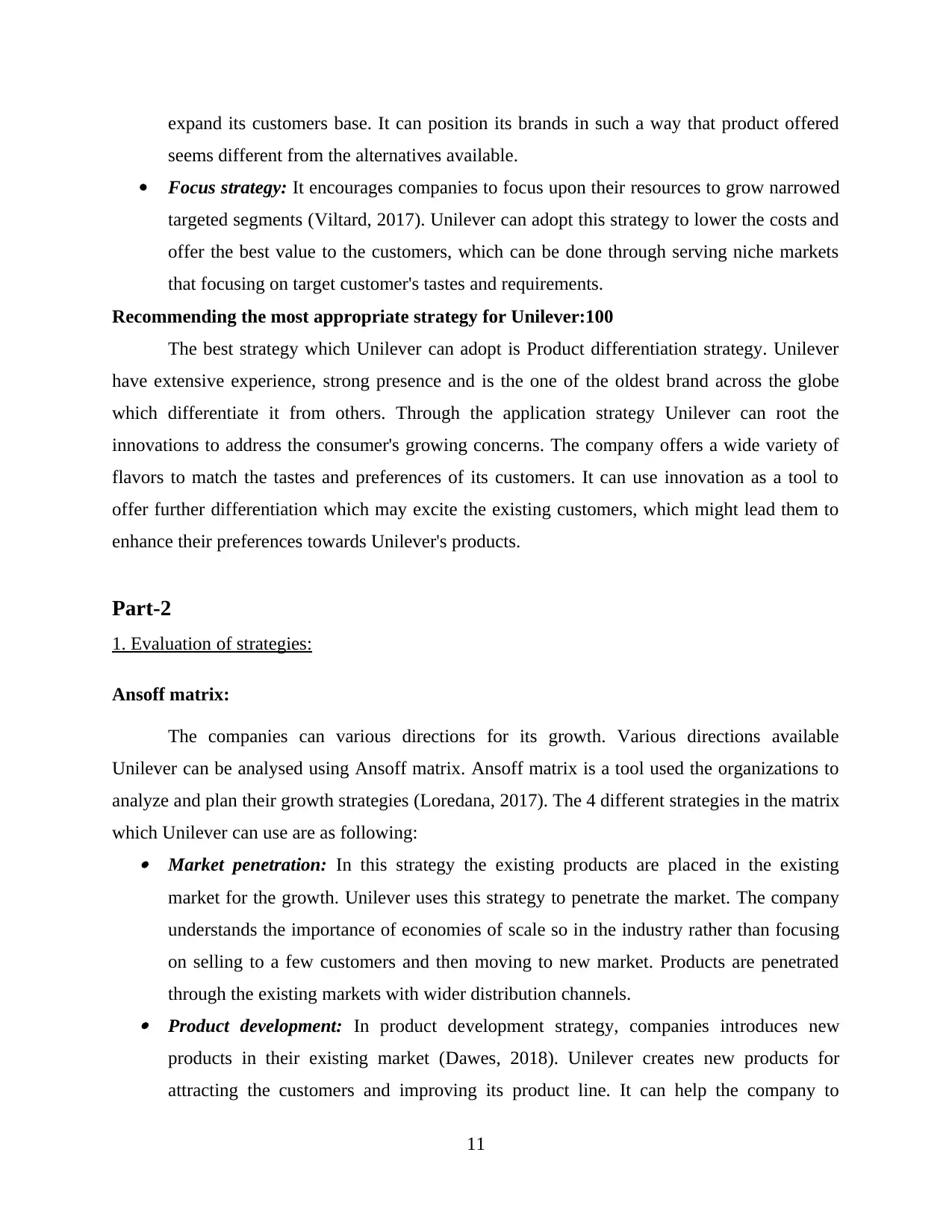
expand its customers base. It can position its brands in such a way that product offered
seems different from the alternatives available.
Focus strategy: It encourages companies to focus upon their resources to grow narrowed
targeted segments (Viltard, 2017). Unilever can adopt this strategy to lower the costs and
offer the best value to the customers, which can be done through serving niche markets
that focusing on target customer's tastes and requirements.
Recommending the most appropriate strategy for Unilever:100
The best strategy which Unilever can adopt is Product differentiation strategy. Unilever
have extensive experience, strong presence and is the one of the oldest brand across the globe
which differentiate it from others. Through the application strategy Unilever can root the
innovations to address the consumer's growing concerns. The company offers a wide variety of
flavors to match the tastes and preferences of its customers. It can use innovation as a tool to
offer further differentiation which may excite the existing customers, which might lead them to
enhance their preferences towards Unilever's products.
Part-2
1. Evaluation of strategies:
Ansoff matrix:
The companies can various directions for its growth. Various directions available
Unilever can be analysed using Ansoff matrix. Ansoff matrix is a tool used the organizations to
analyze and plan their growth strategies (Loredana, 2017). The 4 different strategies in the matrix
which Unilever can use are as following: Market penetration: In this strategy the existing products are placed in the existing
market for the growth. Unilever uses this strategy to penetrate the market. The company
understands the importance of economies of scale so in the industry rather than focusing
on selling to a few customers and then moving to new market. Products are penetrated
through the existing markets with wider distribution channels. Product development: In product development strategy, companies introduces new
products in their existing market (Dawes, 2018). Unilever creates new products for
attracting the customers and improving its product line. It can help the company to
11
seems different from the alternatives available.
Focus strategy: It encourages companies to focus upon their resources to grow narrowed
targeted segments (Viltard, 2017). Unilever can adopt this strategy to lower the costs and
offer the best value to the customers, which can be done through serving niche markets
that focusing on target customer's tastes and requirements.
Recommending the most appropriate strategy for Unilever:100
The best strategy which Unilever can adopt is Product differentiation strategy. Unilever
have extensive experience, strong presence and is the one of the oldest brand across the globe
which differentiate it from others. Through the application strategy Unilever can root the
innovations to address the consumer's growing concerns. The company offers a wide variety of
flavors to match the tastes and preferences of its customers. It can use innovation as a tool to
offer further differentiation which may excite the existing customers, which might lead them to
enhance their preferences towards Unilever's products.
Part-2
1. Evaluation of strategies:
Ansoff matrix:
The companies can various directions for its growth. Various directions available
Unilever can be analysed using Ansoff matrix. Ansoff matrix is a tool used the organizations to
analyze and plan their growth strategies (Loredana, 2017). The 4 different strategies in the matrix
which Unilever can use are as following: Market penetration: In this strategy the existing products are placed in the existing
market for the growth. Unilever uses this strategy to penetrate the market. The company
understands the importance of economies of scale so in the industry rather than focusing
on selling to a few customers and then moving to new market. Products are penetrated
through the existing markets with wider distribution channels. Product development: In product development strategy, companies introduces new
products in their existing market (Dawes, 2018). Unilever creates new products for
attracting the customers and improving its product line. It can help the company to
11
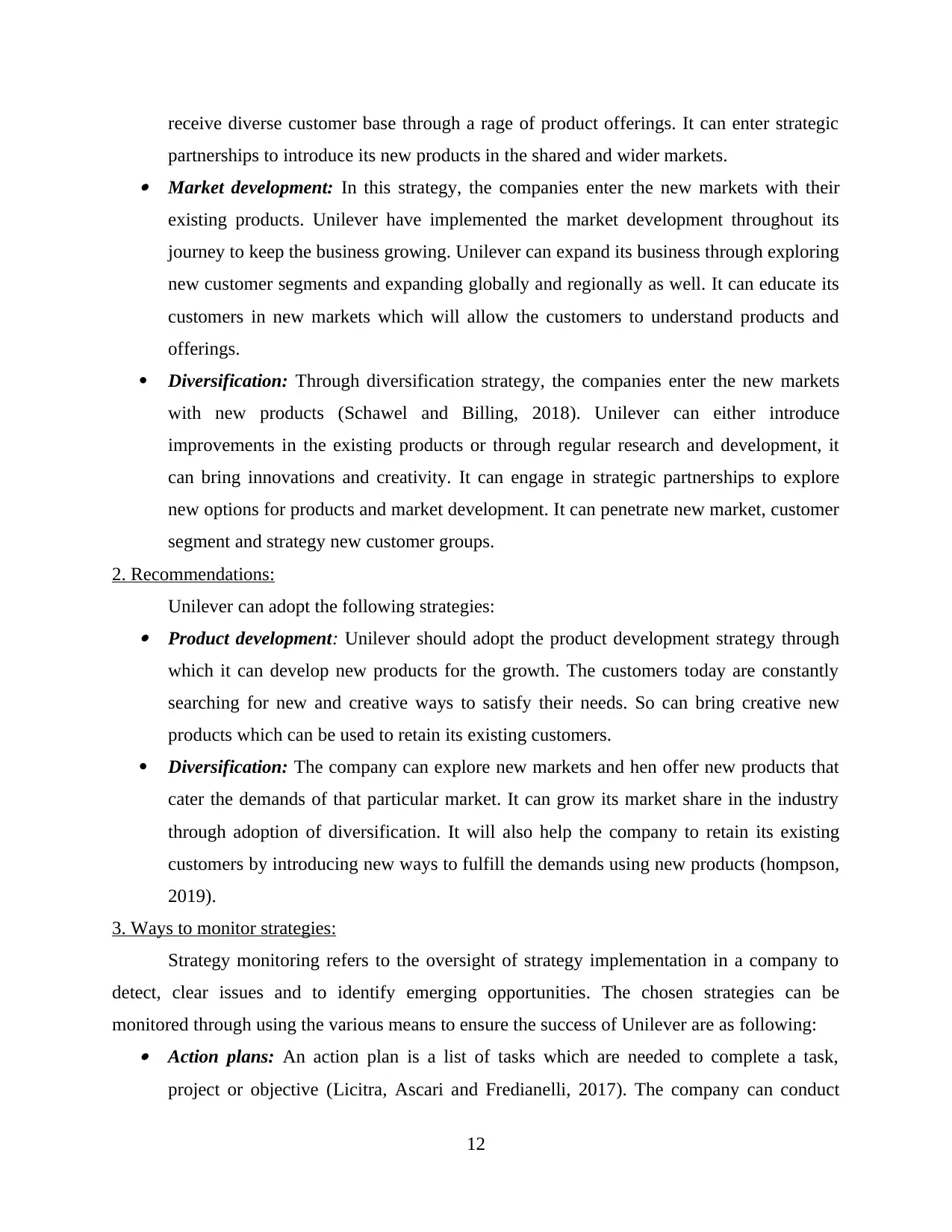
receive diverse customer base through a rage of product offerings. It can enter strategic
partnerships to introduce its new products in the shared and wider markets. Market development: In this strategy, the companies enter the new markets with their
existing products. Unilever have implemented the market development throughout its
journey to keep the business growing. Unilever can expand its business through exploring
new customer segments and expanding globally and regionally as well. It can educate its
customers in new markets which will allow the customers to understand products and
offerings.
Diversification: Through diversification strategy, the companies enter the new markets
with new products (Schawel and Billing, 2018). Unilever can either introduce
improvements in the existing products or through regular research and development, it
can bring innovations and creativity. It can engage in strategic partnerships to explore
new options for products and market development. It can penetrate new market, customer
segment and strategy new customer groups.
2. Recommendations:
Unilever can adopt the following strategies: Product development: Unilever should adopt the product development strategy through
which it can develop new products for the growth. The customers today are constantly
searching for new and creative ways to satisfy their needs. So can bring creative new
products which can be used to retain its existing customers.
Diversification: The company can explore new markets and hen offer new products that
cater the demands of that particular market. It can grow its market share in the industry
through adoption of diversification. It will also help the company to retain its existing
customers by introducing new ways to fulfill the demands using new products (hompson,
2019).
3. Ways to monitor strategies:
Strategy monitoring refers to the oversight of strategy implementation in a company to
detect, clear issues and to identify emerging opportunities. The chosen strategies can be
monitored through using the various means to ensure the success of Unilever are as following: Action plans: An action plan is a list of tasks which are needed to complete a task,
project or objective (Licitra, Ascari and Fredianelli, 2017). The company can conduct
12
partnerships to introduce its new products in the shared and wider markets. Market development: In this strategy, the companies enter the new markets with their
existing products. Unilever have implemented the market development throughout its
journey to keep the business growing. Unilever can expand its business through exploring
new customer segments and expanding globally and regionally as well. It can educate its
customers in new markets which will allow the customers to understand products and
offerings.
Diversification: Through diversification strategy, the companies enter the new markets
with new products (Schawel and Billing, 2018). Unilever can either introduce
improvements in the existing products or through regular research and development, it
can bring innovations and creativity. It can engage in strategic partnerships to explore
new options for products and market development. It can penetrate new market, customer
segment and strategy new customer groups.
2. Recommendations:
Unilever can adopt the following strategies: Product development: Unilever should adopt the product development strategy through
which it can develop new products for the growth. The customers today are constantly
searching for new and creative ways to satisfy their needs. So can bring creative new
products which can be used to retain its existing customers.
Diversification: The company can explore new markets and hen offer new products that
cater the demands of that particular market. It can grow its market share in the industry
through adoption of diversification. It will also help the company to retain its existing
customers by introducing new ways to fulfill the demands using new products (hompson,
2019).
3. Ways to monitor strategies:
Strategy monitoring refers to the oversight of strategy implementation in a company to
detect, clear issues and to identify emerging opportunities. The chosen strategies can be
monitored through using the various means to ensure the success of Unilever are as following: Action plans: An action plan is a list of tasks which are needed to complete a task,
project or objective (Licitra, Ascari and Fredianelli, 2017). The company can conduct
12
You're viewing a preview
Unlock full access by subscribing today!
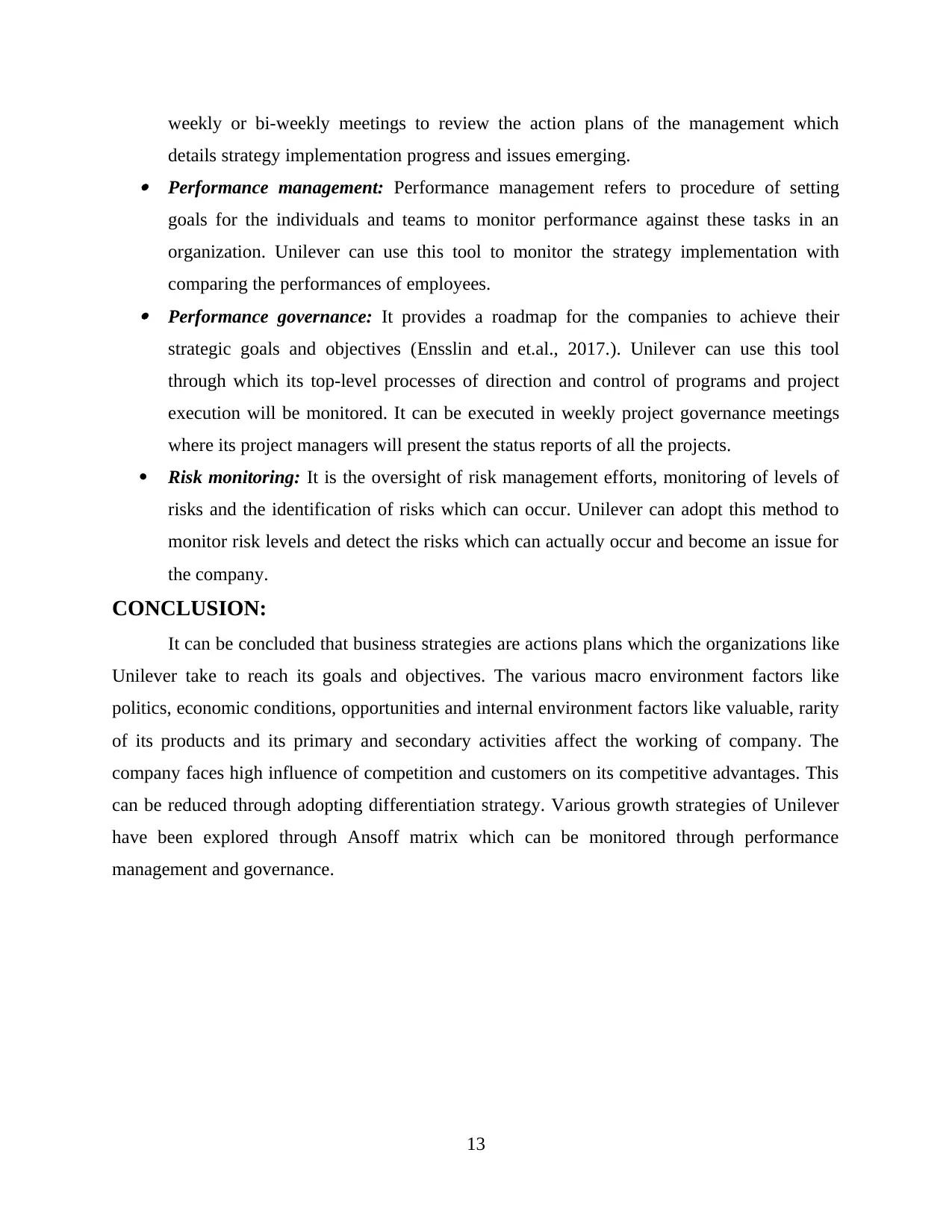
weekly or bi-weekly meetings to review the action plans of the management which
details strategy implementation progress and issues emerging. Performance management: Performance management refers to procedure of setting
goals for the individuals and teams to monitor performance against these tasks in an
organization. Unilever can use this tool to monitor the strategy implementation with
comparing the performances of employees. Performance governance: It provides a roadmap for the companies to achieve their
strategic goals and objectives (Ensslin and et.al., 2017.). Unilever can use this tool
through which its top-level processes of direction and control of programs and project
execution will be monitored. It can be executed in weekly project governance meetings
where its project managers will present the status reports of all the projects.
Risk monitoring: It is the oversight of risk management efforts, monitoring of levels of
risks and the identification of risks which can occur. Unilever can adopt this method to
monitor risk levels and detect the risks which can actually occur and become an issue for
the company.
CONCLUSION:
It can be concluded that business strategies are actions plans which the organizations like
Unilever take to reach its goals and objectives. The various macro environment factors like
politics, economic conditions, opportunities and internal environment factors like valuable, rarity
of its products and its primary and secondary activities affect the working of company. The
company faces high influence of competition and customers on its competitive advantages. This
can be reduced through adopting differentiation strategy. Various growth strategies of Unilever
have been explored through Ansoff matrix which can be monitored through performance
management and governance.
13
details strategy implementation progress and issues emerging. Performance management: Performance management refers to procedure of setting
goals for the individuals and teams to monitor performance against these tasks in an
organization. Unilever can use this tool to monitor the strategy implementation with
comparing the performances of employees. Performance governance: It provides a roadmap for the companies to achieve their
strategic goals and objectives (Ensslin and et.al., 2017.). Unilever can use this tool
through which its top-level processes of direction and control of programs and project
execution will be monitored. It can be executed in weekly project governance meetings
where its project managers will present the status reports of all the projects.
Risk monitoring: It is the oversight of risk management efforts, monitoring of levels of
risks and the identification of risks which can occur. Unilever can adopt this method to
monitor risk levels and detect the risks which can actually occur and become an issue for
the company.
CONCLUSION:
It can be concluded that business strategies are actions plans which the organizations like
Unilever take to reach its goals and objectives. The various macro environment factors like
politics, economic conditions, opportunities and internal environment factors like valuable, rarity
of its products and its primary and secondary activities affect the working of company. The
company faces high influence of competition and customers on its competitive advantages. This
can be reduced through adopting differentiation strategy. Various growth strategies of Unilever
have been explored through Ansoff matrix which can be monitored through performance
management and governance.
13
Paraphrase This Document
Need a fresh take? Get an instant paraphrase of this document with our AI Paraphraser
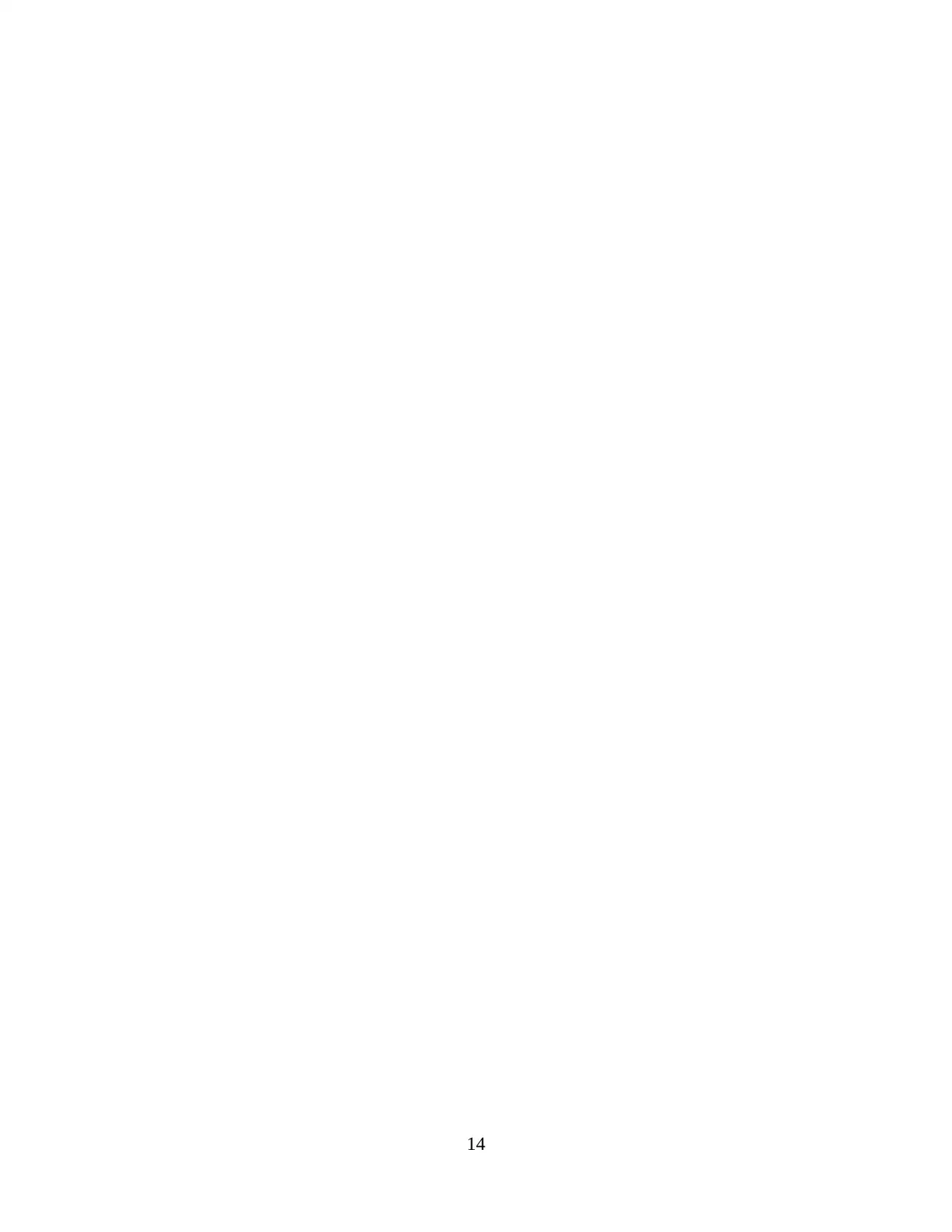
14
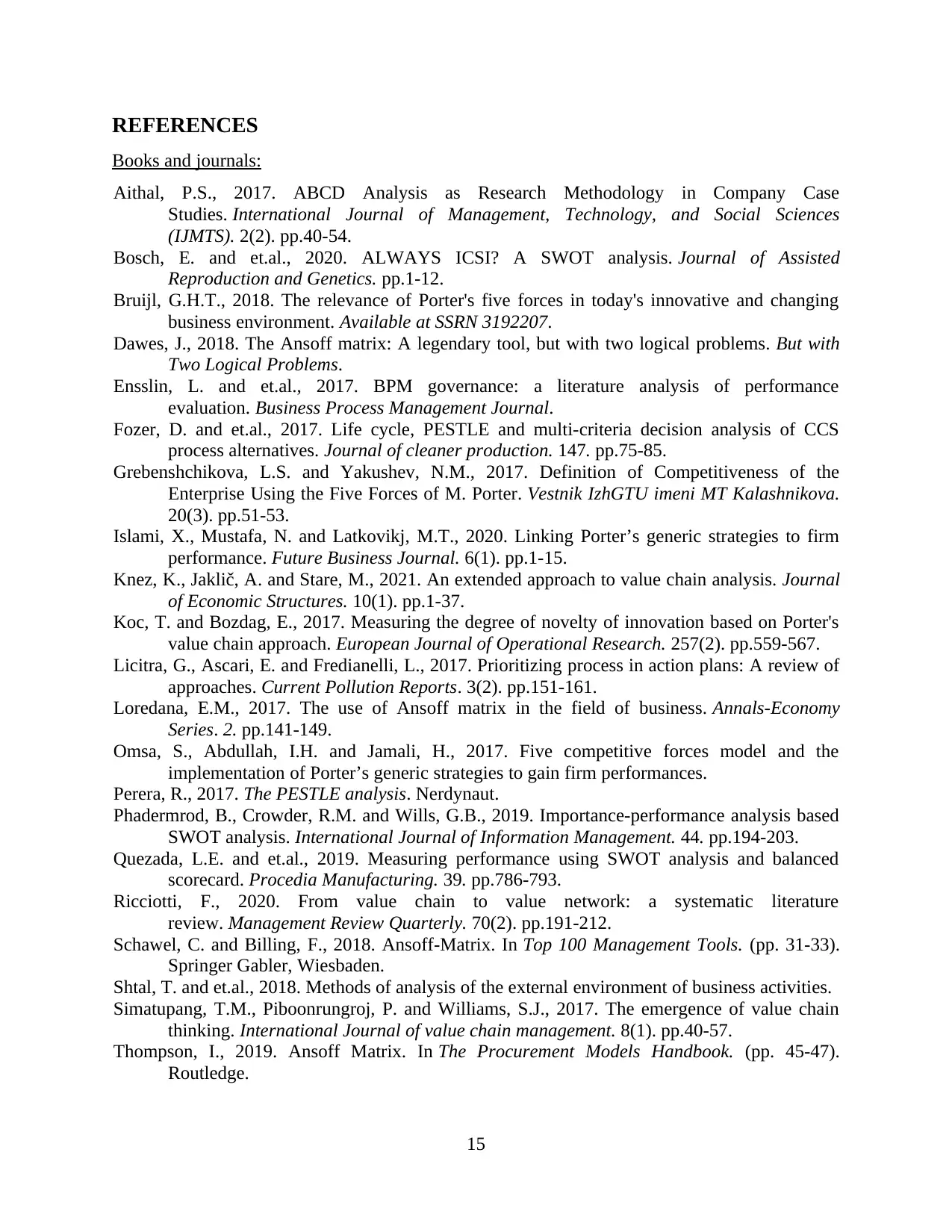
REFERENCES
Books and journals:
Aithal, P.S., 2017. ABCD Analysis as Research Methodology in Company Case
Studies. International Journal of Management, Technology, and Social Sciences
(IJMTS). 2(2). pp.40-54.
Bosch, E. and et.al., 2020. ALWAYS ICSI? A SWOT analysis. Journal of Assisted
Reproduction and Genetics. pp.1-12.
Bruijl, G.H.T., 2018. The relevance of Porter's five forces in today's innovative and changing
business environment. Available at SSRN 3192207.
Dawes, J., 2018. The Ansoff matrix: A legendary tool, but with two logical problems. But with
Two Logical Problems.
Ensslin, L. and et.al., 2017. BPM governance: a literature analysis of performance
evaluation. Business Process Management Journal.
Fozer, D. and et.al., 2017. Life cycle, PESTLE and multi-criteria decision analysis of CCS
process alternatives. Journal of cleaner production. 147. pp.75-85.
Grebenshchikova, L.S. and Yakushev, N.M., 2017. Definition of Competitiveness of the
Enterprise Using the Five Forces of M. Porter. Vestnik IzhGTU imeni MT Kalashnikova.
20(3). pp.51-53.
Islami, X., Mustafa, N. and Latkovikj, M.T., 2020. Linking Porter’s generic strategies to firm
performance. Future Business Journal. 6(1). pp.1-15.
Knez, K., Jaklič, A. and Stare, M., 2021. An extended approach to value chain analysis. Journal
of Economic Structures. 10(1). pp.1-37.
Koc, T. and Bozdag, E., 2017. Measuring the degree of novelty of innovation based on Porter's
value chain approach. European Journal of Operational Research. 257(2). pp.559-567.
Licitra, G., Ascari, E. and Fredianelli, L., 2017. Prioritizing process in action plans: A review of
approaches. Current Pollution Reports. 3(2). pp.151-161.
Loredana, E.M., 2017. The use of Ansoff matrix in the field of business. Annals-Economy
Series. 2. pp.141-149.
Omsa, S., Abdullah, I.H. and Jamali, H., 2017. Five competitive forces model and the
implementation of Porter’s generic strategies to gain firm performances.
Perera, R., 2017. The PESTLE analysis. Nerdynaut.
Phadermrod, B., Crowder, R.M. and Wills, G.B., 2019. Importance-performance analysis based
SWOT analysis. International Journal of Information Management. 44. pp.194-203.
Quezada, L.E. and et.al., 2019. Measuring performance using SWOT analysis and balanced
scorecard. Procedia Manufacturing. 39. pp.786-793.
Ricciotti, F., 2020. From value chain to value network: a systematic literature
review. Management Review Quarterly. 70(2). pp.191-212.
Schawel, C. and Billing, F., 2018. Ansoff-Matrix. In Top 100 Management Tools. (pp. 31-33).
Springer Gabler, Wiesbaden.
Shtal, T. and et.al., 2018. Methods of analysis of the external environment of business activities.
Simatupang, T.M., Piboonrungroj, P. and Williams, S.J., 2017. The emergence of value chain
thinking. International Journal of value chain management. 8(1). pp.40-57.
Thompson, I., 2019. Ansoff Matrix. In The Procurement Models Handbook. (pp. 45-47).
Routledge.
15
Books and journals:
Aithal, P.S., 2017. ABCD Analysis as Research Methodology in Company Case
Studies. International Journal of Management, Technology, and Social Sciences
(IJMTS). 2(2). pp.40-54.
Bosch, E. and et.al., 2020. ALWAYS ICSI? A SWOT analysis. Journal of Assisted
Reproduction and Genetics. pp.1-12.
Bruijl, G.H.T., 2018. The relevance of Porter's five forces in today's innovative and changing
business environment. Available at SSRN 3192207.
Dawes, J., 2018. The Ansoff matrix: A legendary tool, but with two logical problems. But with
Two Logical Problems.
Ensslin, L. and et.al., 2017. BPM governance: a literature analysis of performance
evaluation. Business Process Management Journal.
Fozer, D. and et.al., 2017. Life cycle, PESTLE and multi-criteria decision analysis of CCS
process alternatives. Journal of cleaner production. 147. pp.75-85.
Grebenshchikova, L.S. and Yakushev, N.M., 2017. Definition of Competitiveness of the
Enterprise Using the Five Forces of M. Porter. Vestnik IzhGTU imeni MT Kalashnikova.
20(3). pp.51-53.
Islami, X., Mustafa, N. and Latkovikj, M.T., 2020. Linking Porter’s generic strategies to firm
performance. Future Business Journal. 6(1). pp.1-15.
Knez, K., Jaklič, A. and Stare, M., 2021. An extended approach to value chain analysis. Journal
of Economic Structures. 10(1). pp.1-37.
Koc, T. and Bozdag, E., 2017. Measuring the degree of novelty of innovation based on Porter's
value chain approach. European Journal of Operational Research. 257(2). pp.559-567.
Licitra, G., Ascari, E. and Fredianelli, L., 2017. Prioritizing process in action plans: A review of
approaches. Current Pollution Reports. 3(2). pp.151-161.
Loredana, E.M., 2017. The use of Ansoff matrix in the field of business. Annals-Economy
Series. 2. pp.141-149.
Omsa, S., Abdullah, I.H. and Jamali, H., 2017. Five competitive forces model and the
implementation of Porter’s generic strategies to gain firm performances.
Perera, R., 2017. The PESTLE analysis. Nerdynaut.
Phadermrod, B., Crowder, R.M. and Wills, G.B., 2019. Importance-performance analysis based
SWOT analysis. International Journal of Information Management. 44. pp.194-203.
Quezada, L.E. and et.al., 2019. Measuring performance using SWOT analysis and balanced
scorecard. Procedia Manufacturing. 39. pp.786-793.
Ricciotti, F., 2020. From value chain to value network: a systematic literature
review. Management Review Quarterly. 70(2). pp.191-212.
Schawel, C. and Billing, F., 2018. Ansoff-Matrix. In Top 100 Management Tools. (pp. 31-33).
Springer Gabler, Wiesbaden.
Shtal, T. and et.al., 2018. Methods of analysis of the external environment of business activities.
Simatupang, T.M., Piboonrungroj, P. and Williams, S.J., 2017. The emergence of value chain
thinking. International Journal of value chain management. 8(1). pp.40-57.
Thompson, I., 2019. Ansoff Matrix. In The Procurement Models Handbook. (pp. 45-47).
Routledge.
15
You're viewing a preview
Unlock full access by subscribing today!
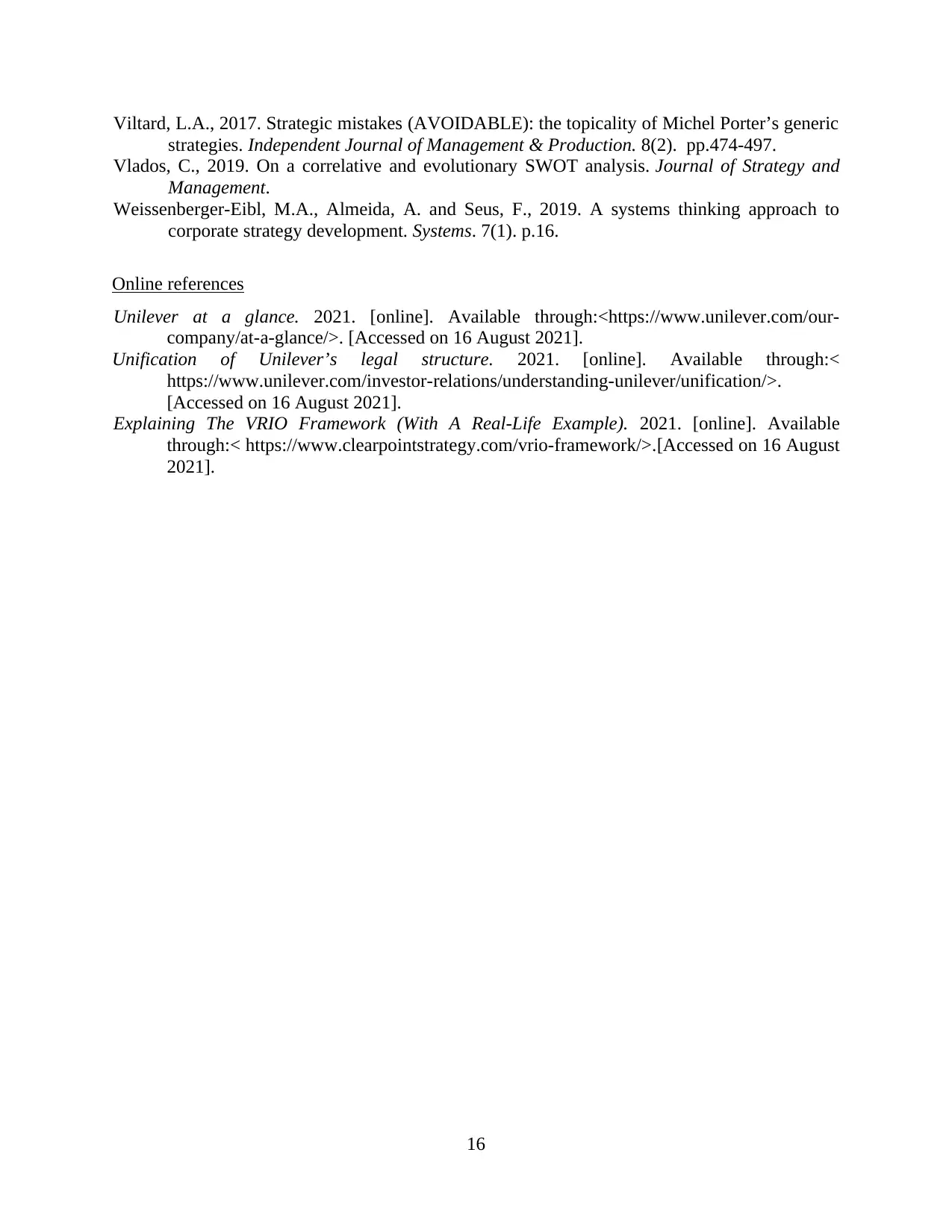
Viltard, L.A., 2017. Strategic mistakes (AVOIDABLE): the topicality of Michel Porter’s generic
strategies. Independent Journal of Management & Production. 8(2). pp.474-497.
Vlados, C., 2019. On a correlative and evolutionary SWOT analysis. Journal of Strategy and
Management.
Weissenberger-Eibl, M.A., Almeida, A. and Seus, F., 2019. A systems thinking approach to
corporate strategy development. Systems. 7(1). p.16.
Online references
Unilever at a glance. 2021. [online]. Available through:<https://www.unilever.com/our-
company/at-a-glance/>. [Accessed on 16 August 2021].
Unification of Unilever’s legal structure. 2021. [online]. Available through:<
https://www.unilever.com/investor-relations/understanding-unilever/unification/>.
[Accessed on 16 August 2021].
Explaining The VRIO Framework (With A Real-Life Example). 2021. [online]. Available
through:< https://www.clearpointstrategy.com/vrio-framework/>.[Accessed on 16 August
2021].
16
strategies. Independent Journal of Management & Production. 8(2). pp.474-497.
Vlados, C., 2019. On a correlative and evolutionary SWOT analysis. Journal of Strategy and
Management.
Weissenberger-Eibl, M.A., Almeida, A. and Seus, F., 2019. A systems thinking approach to
corporate strategy development. Systems. 7(1). p.16.
Online references
Unilever at a glance. 2021. [online]. Available through:<https://www.unilever.com/our-
company/at-a-glance/>. [Accessed on 16 August 2021].
Unification of Unilever’s legal structure. 2021. [online]. Available through:<
https://www.unilever.com/investor-relations/understanding-unilever/unification/>.
[Accessed on 16 August 2021].
Explaining The VRIO Framework (With A Real-Life Example). 2021. [online]. Available
through:< https://www.clearpointstrategy.com/vrio-framework/>.[Accessed on 16 August
2021].
16
1 out of 16
Related Documents
Your All-in-One AI-Powered Toolkit for Academic Success.
+13062052269
info@desklib.com
Available 24*7 on WhatsApp / Email
![[object Object]](/_next/static/media/star-bottom.7253800d.svg)
Unlock your academic potential
© 2024 | Zucol Services PVT LTD | All rights reserved.




